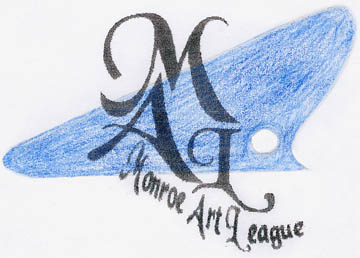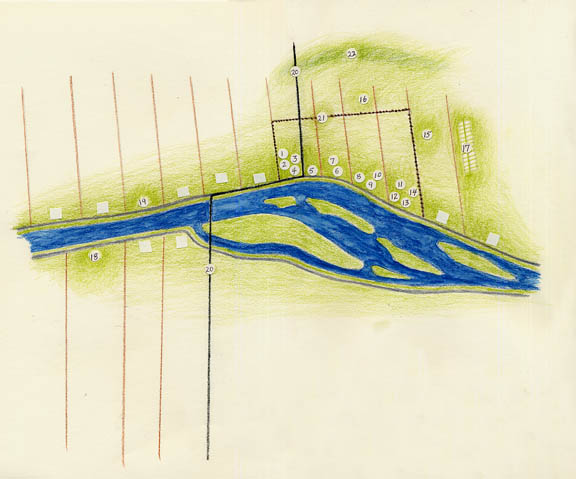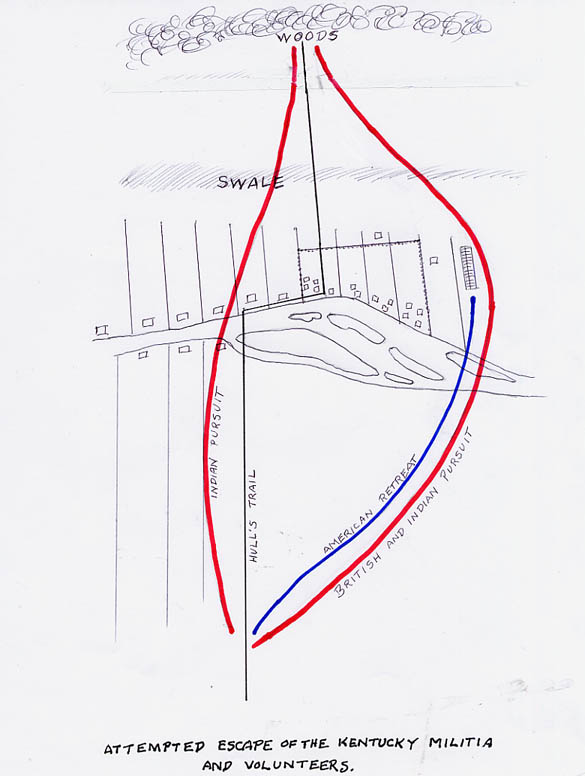War of 1812 -- The River Raisin Massacre


The Battle of Frenchtown (Battle of the River Raisin in Monroe, Michigan) was the largest battle fought on Michigan soil. This was a major defeat for the Americans and was one of the bloodiest engagements during the War of 1812. The massacre of some wounded soldiers the following day shocked and enraged Americans throughout the Old Northwest Territory. this incident soon became known as the "River Raisin Massacre" and the rallying cry "Remember the Raisin."
Although the United States had already won its independence from Great Britan, the British forces stationed at Fort Malden in Canada continued to harass Fort Detroit, resulting in the surrender on August 16, 1812, of America's General William Hull to British Major General Henry Proctor.
Determined to reclaim Detroit, President James Madison placed General William Harrison in command of operations. Second in command was the unpopular Brigadier General James Winchester, who was considered to be inept, and at age sixty-one, past his prime.
Swampy terrain delayed transport of heavy artillery and troops north, so further movement was halted awaiting winter, when ground and waterways were frozen.
Having been gone from home for three months, Winchester's men suffered greatly, shivering in crudely made huts, eating half rations when available, wearing tattered, light weight garments, and being encamped 100 miles from human habitation where some sort of relief might be sought.
Frenchtown, being occupied by British and Indians, sent pleas for help, and Winchester, against Harrison's orders, sent Colonel Lewis with a relief detachment. Traveling on the frozen surfaces down the Maumee River, along the western shore of Lake Erie, and north on the River Raisin, they reached Frenchtown on Jan. 18, 1813 to drive away the detachment of British and Indians. Two days later Winchester and reinforcements joined Lewis. Despite reports that Proctor and a large force were moving to counterattack, Winchester presumed such a plan would require 'some days' to implement. Consequently, while his men were encamped without adequate security in Frenchtown, he spent the night in the cabin of Colonel Frances Navarre located on the south side of the river, one mile west of the settlement. While guards were posted as usual, none guarded the road north.
On the night of January 21, 1813, Proctor assembled his army five miles north of Frenchtown, launching a surprise attack before sunrise on the morning of January 22.
American regulars quickly returned fire from behind fencerow, but were
shortly driven back.
Kentucky militiamen attempting to reinforce the
regulars were also overwhelmed.
Awakened by the sound of battle, Winchester rode a horse held in readiness by his host, arriving to see the right flank crumbling, as his regulars attempted to retreat south along Hull's road. Pursuing in an attempt to re-form the regulars, he was captured by Indians, while most of his men on ahead were massacred. Very few made good their escape.
Unaware of this, the Kentuckians fought on loyally in Frenchtown, having vowed to fight to the end, saying they 'would rather die on the field' than surrender. Also during the rout the brave U.S. regulars broke into small groups and continued to fight until overwhelmed.
After threats and arguments between American and British officers, Proctor promised to save Frenchtown from being burned and the wounded from being killed by Indians, if the Kentuckians would surrender. Reluctantly, surrender took place.On January 22, 1813, Proctor departed for Fort Malden with the British regulars, Canadian militia, and American prisoners who were able to walk. There were not enough sleighs to carry all of the American wounded, so many were left behind in the care of several volunteers and two surgeons. A Captain William Elliott and three interpreters were also to remain and guard the wounded, but all four left before the night ended.
At 10:00 a.m. on January 23rd approximately 200 Indians entered Frenchtown, invading buildings and stripping the wounded of their belongings. Some who could walk were taken captive.
Buildings housing the seriously wounded were burned. Persons able to crawl to safety were tomahawked at the door.
The massacre continued until mid afternoon, when the Indians and
captured wounded left for Fort Malden.
Prisoners unable to keep up were
brutally killed, with 30 or 40 mangled bodies reportedly strewn along the
way.
Many scalps were taken during those two days of brutal massacre.

Area map showing building notations
1. Barn property of Godfroy & Beugrand
2. Stable (#1)
3. Store house of (#1) in which was stored a quanity of salt belingings to the army.
4. Dwelling house (#1)
5. Dwelling house of Col. Hubert Lacroix -- at this time unfinished -- occupied as barracks for the troops.
6. Dwelling house of George McDougall
7. Stable belonging to McDougall.
8. Dwelling house of John Baptiste Jerome -- occupied and used by the troops as a guard house.
9. Dwelling house of John Baptiste Jerome -- occupied by the army as a hospital, wounded massacred by Indians.
10. Stable belonging to John Baptiste Jerome -- occupied and used by the army to stable their horses.
11. Stable, the property of Captain John Baptiste Couture - in which was left the horses of the officers Major Garriitt (Garrard), etc.
12. Store house of Captain John Baptiste Couture -- occupied by the quartermaster & in which was kept the provisions for the army & from which rations were issued or given out.
13. Dwelling house of Captain John Baptiste Couture -- occupied as quarters by the officers among whom Col. Lewis Col. Allen, Major Garritt (Garrard), Captain Hart, John McCalla, Joseph Winchester, Ensign Baker, Doc. Bowers, Dr. Todd, Doc. McIlvane, captain Smith (?) & Major Madison.
14. Bake house of Captain John Baptiste Couture -- occupied by Captain McCracken & a part of his company.
15. Barn of Col. Gabriel Godfroy burned by order of the officer then in command to prevent its being a shelter to the British in their approach to the American lines.
16. Barn of John Baptiste Jerome burned likewise and for the same reason by order of the officer then in command. British cannon stationed on this ground along inside of swale or marsh in open field.
17. Tend encampment of Col. Wells Battalion, which retreated across the river on Hull's trail and were cut off by Indians under the command of Col. Elliot.
18. Home of Col. Francis Navarre serving as headquarters of General Winchester.
19. Home of Fransoil LaSalle where Capt. Hart was shot while prisoner of Indians. (Possibly error in identity was made and victim was actually Winchester's secretary, Capt. Wolfolk.)
20. Hull's trail to Detroit.
21. Six foot high puncheon fence.

Attempted Escape of the Kentucky Militia and Volunteers